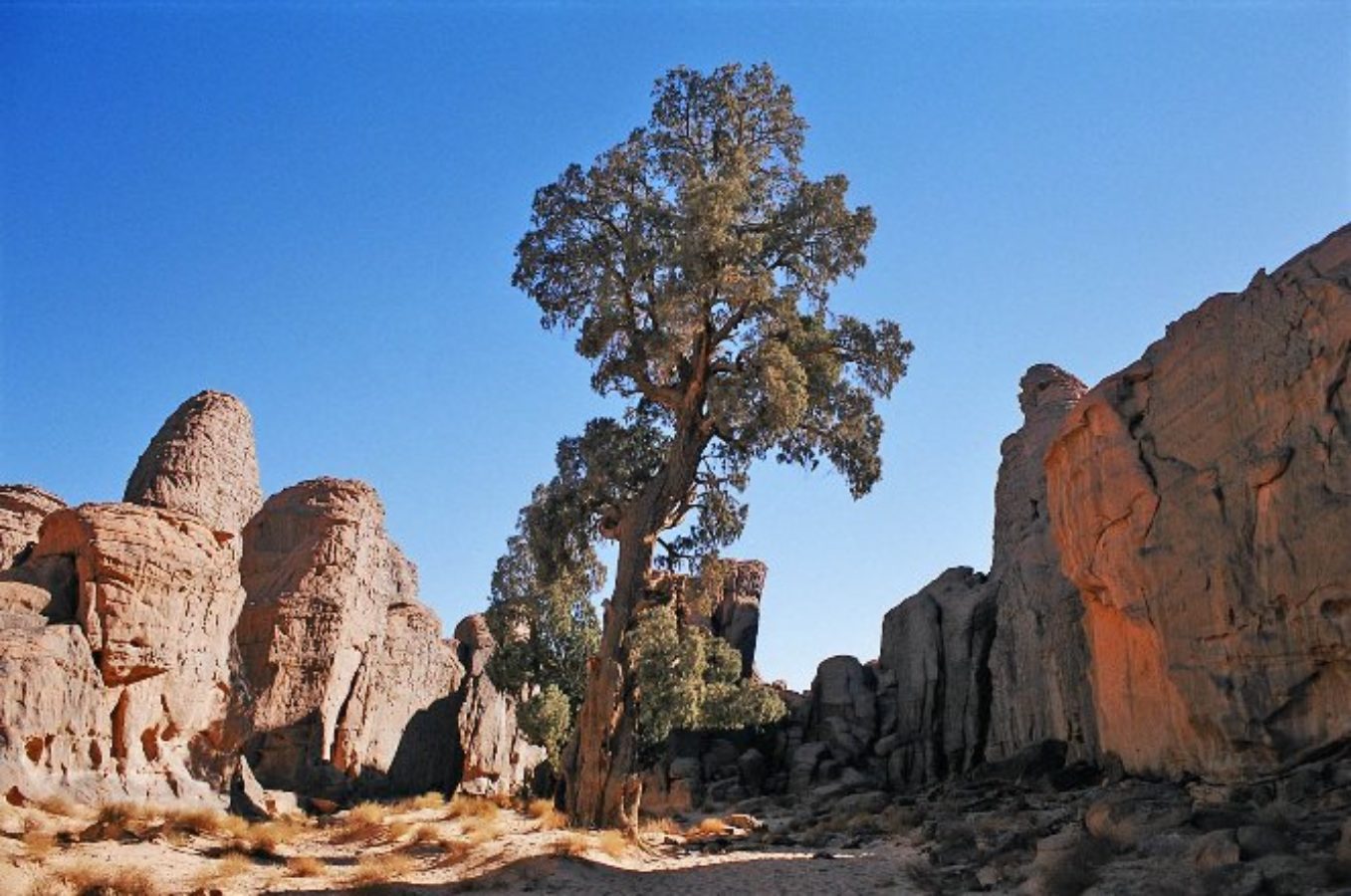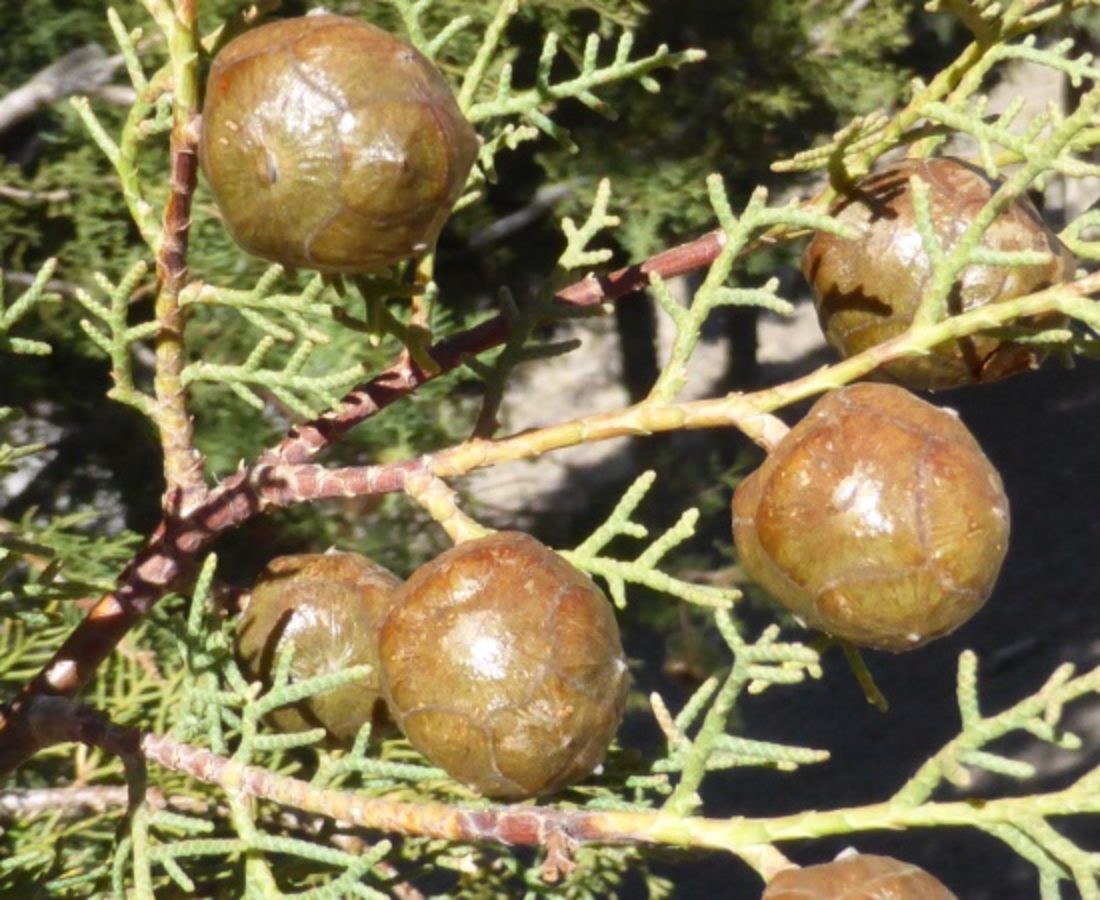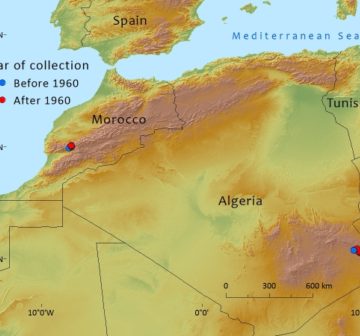Cupressaceae
Cupressus dupreziana
Represented by the two varieties C. dupreziana var. dupreziana (Algeria) and C. dupreziana var. atlantica (Morocco). Long-lived (2000 years) but their future is threatened by fire, seed collecting and climate change.
Description
Habit
Tree 16–18m tall, monoecious; trunk, d.b.h. 2–3m. Bark thick, deeply fissured, exfoliating in longitudinal strips. Branches spreading or ascending, forming a conical or pyramidal tree.
Foliage
Spreading or drooping to pendulous. Leaves, scale-like (all equal in size), arranged in opposite pairs at right angles to those above or below, overlapping, gradually tapering, with glands, stomata few and scattered on margins near leaf base; shiny greyish-green or glaucous green.
Cones
Male pollen-cones on branches close to female cones, solitary, terminal, ovoid, 4–6 x 2–3mm, yellowish-brown when mature. Female seed-cones solitary on lateral branches, terminal on short leafy branchlets, subglobose to ovoid-oblong, 15–27 x 13–21mm, light brown when mature; bract-scale complexes 10–12 in opposite pairs at right angles to those above or below. Seeds 6–8mm, closely packed, ovoid-globose, or more angular, flattened, dark brown, wings 2 on opposite sides, 1–2mm wide.
Human Uses
In Morocco, historically, the wood was utilized for making joists and beams in order to build houses and in the building of large gates for the entrances of old town walls (Bellefontaine, 1979; Achhal, 1986). The larger branches of the trees were utilized to make chairs and tables and other furniture and the smaller branches were collected during the summer and stored for winter feed for the local Berber herds of goats and donkeys. Today substantial amounts of seeds are collected annually for commercial horticulture. In Algeria the wood was highly valued for construction and carpentry and today the main use is for fuel.
References and further reading
- Abdoun, F. (1999). La population de cyprès du Tassili en voie de disparition. Symbiose. 7: 23-29.
- Abdoun, F. (2002). Etude de la dynamique spatio-temporelle des populations de Cupressus dupreziana A. Camus au Tassili n’Ajjer, Algérie. Thèse Doc., Université d’Aix-Marseille III, 171 pp.
- Abdoun F. (2006). Analyse rétrospective des projets de protection et de réintroduction du cyprès du Tassili dans son aire naturelle et dans le monde, Journées Internationales sur la Désertification et le Développement Durable, Biskra.
- Abdoun, F. & M. Beddiaf (2002). Cupressus dupreziana A. Camus, répartition, dépérissement et régénération au Tassili n’Ajjer, Sahara Central. Comptes Rendus Biologie. 325: 617-627
- Abdoun, F., Gardner, M. & Griffiths, A. (2013). Cupressus dupreziana. In: IUCN 2013. IUCN Red List of Threatened Species. Version 2013.1. <www.iucnredlist.org>. Downloaded on 05 July 2013.
- Achhal, A. (1986.) Etude phytosociologique et dendrometrique des écosystèmes forestière du Bassin versant du N’Fiss (Haut Atlas central). Ph.D. Université de droit d’economie et des Sciences d’Aix Marseille: France.
- Bechir, A., El Mousadik, A. & Pichot, C. (2004). Allozyme diversity of natural and introduced cypress stands in Morocco: consequences for management of genetic resources. Annals of Forest Science. 61(7): 669-676.
- Bellefontaine, R. (1979). Vigeur de croissance du cyprès d’Atlas dans son aire naturelle et dans son aire d’introduction au Maroc. Ann. Rech. Forest. 19: 235-273.
- Benhouhou, S., Boucheneb, N., Sahli, F. & Idrissa Yaou, A. (2005). Le cyprès du Tassili : caractérisation floristique et écologique = Floristic and ecological characterisation of the Tassili cypress. Sécheresse. 16(1) : 61-66.
- Balachowsky, A.S. (1955). Une relique rarissime du Sahara Central : le cyprès de Duprez.. La Nature. 3237: 20-24.
- Barry, J.P., Belin, B, Celles, J.C., Dubost, D., Faurel, L. & Hethener, P. (1970). Essai de monographie du Cupressus dupreziana A. Camus cyprès end´emique du Tassili des Ajjer (Sahara Central). Bull. Soc. Hist. Nat. Afrique Nord. 61(112):95–178.
- Boudy, P. (1950). Economie forestière nord-africaine. Monographie et traitment des essences forestières. 2: 764-771. Paris : Editions Larose.
- Camus, A. (1958). Sur un Cupressus relique de la Forét du Tassili. J. Agric. Trop. Bot. Appl. 5:766-7.
- Capot-Rey, R. (1954). Une crue de l'O. Edjréou, Trav. Inst. Rech. Sahar. 11 :111-116.
- Dubief, J. (1963). Le climat du Sahara. Trav. Inst. Rech. Sahar, h.s. II:275
- Griffiths, A. J. K. (1998). Taxonomic and conservation status of Cupressus atlantica. Reading. Unpublished PhD Thesis, University of Reading.
- Lavauden, L. (1926). Sur la présence d’un cypr`es dans les montagnes du Tassili des Azdjers. Comptes. Rendus. Acad. Sci.182:541–543
- Leredde, C. (1957). Etude écologique et phytogéographique du Tassili n’Ajjer. Trav. Inst. Rech. Sahar. II:455
- Pichot, C., Fady, B., & Hochu, I. (2000). Lack of mother tree alleles in zymograms of Cupressus dupreziana A. Camus embryos. Ann. For. Sci. 57: 17–22
- Pichot, C., El Maátaoui, M., Raddi, S. & Raddi, P. (2001). Surrogate mother for endangered Cupressus. Nature. 412: 39.
- Rushforth, K., Adams, R. P., Zhong, M., X.-Giang Ma & Pandey, R. N. (2003). Variation among Cupressus species from the eastern hemisphere based on Random Amplified Polymorphic DNAs (RAPDs). Biochemical Systematics and Ecology. 31:17–24
- Silba, J. (1998). A monograph of the genus Cupressus L. J. Int. Conifer Preserv. Soc. 5 (2): 1-98
- Sekiewicz, K., M. Sekiewicz, A. Romo, Y. Didukh, M. Fennane & A. Boratynski (2014). Chorological and conservation status of the endemic cypress, Cupressus atlantica Gaussen, in the High Atlas (Morocco). Dendrobiology 71:3-13.
- Sekiewicz, K., K. Boratynska, M.B. Dagher-kharrat, T. Ok, A. Boratynski (2016). Taxonomic differentiation of Cupressus sempervirens and C. atlantica based on morphometric evidence. Systematics and Biodiversity DOI:10.1080/14772000.2016.1171260.
- Stewart, P. (1969). Cupressus dupreziana, threatened conifer of the Sahara. Biol. Conserv. 2(1):10–12
- Stewart, P. J. (1986). Cupressus atlantica. In: FAO Forestry Department (compiler). Databook on endangered tree and shrub species and their provenances. Rome: FAO. 524 pp.
- Xenopoulos, S., Andreoli, C., Panconesi, A., Pinto Ganhao, J. & Tuset, J. J. [date unkn.] Importance of Cypress, pp 1-14 in J. Ponchet (ed.), AGRIMED research programme. Progress in EEC research on cypress diseases. Results of the Agrimed project (1980-1988). Luxembourg: Commision of the
- Yani, A., Baradat, P. & Bernard-Dagan, C. (1990). II. Chemotaxonomy of Cupressus species, pp 29-38 in J. Ponchet (ed.), AGRIMED research programme. Progress in EEC research on cypress diseases. Results of the Agrimed project (1980-1988). Luxembourg: Commision of the European CommunitiesCommunities











